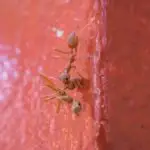How Big Were Ants in Prehistoric Times?
Until now, the answer to the question, “how big were ants in prehistoric times?” was not entirely clear. However, the discovery of a fossil of a giant ant in Wyoming, United States, is shedding new light on the history of insects and the spread of plants and animals after the dinosaurs died.
The fossil is 49 million years old and is the first known giant ant in the Western Hemisphere. The ant, which is now named Titanomyrma lubei, was over two inches long and would have been about the size of a hummingbird without a beak.
The fossil is only a portion of a larger species, but it indicates that the ants were able to cross from Europe to North America during a warm period in Earth’s history. Many plants and animals were able to migrate from Europe to North America during this time, as a result of land bridges that existed between the continents.
These bridges are thought to have existed in Greenland, Iceland, and Northern Routes, which would have allowed the tropical lineages to cross the Arctic and reach the continents. The warm climate at this time would have been a result of increased greenhouse gas emissions, which led to the rise in Earth’s temperature.
The study has been funded by the National Science Foundation’s Division of Environmental Biology. Lead author Bruce Archibald is a paleoentomologist at Simon Fraser University in British Columbia, Canada. He explains, “The idea of the land bridge is that we’re crossing an Arctic land bridge. If the Arctic was warmer, then there would have been a lot of migration between Europe and North America.








